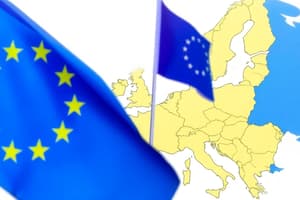Podcast
Questions and Answers
What was the purpose of Juan de Plasencia's document 'THE CUSTOMS of the Tagalogs'?
What was the purpose of Juan de Plasencia's document 'THE CUSTOMS of the Tagalogs'?
- To provide information about the culture of the Tagalogs in Luzon. (correct)
- To discuss the economic activities of the Tagalogs.
- To describe the flora and fauna in the Tagalog region.
- To analyze the political system of the Spanish monarchy.
What did the Tagalogs call their chiefs?
What did the Tagalogs call their chiefs?
- Emperors
- Datos (correct)
- Kings
- Sultans
Why were subject who committed offenses against the chiefs severely punished?
Why were subject who committed offenses against the chiefs severely punished?
- Because they were exiled from the community.
- Because they had to pay a fine.
- Because it was a way to maintain order and respect for the chiefs. (correct)
- Because they were promoted to become chiefs.
What is a 'barangay' in Tagalog culture?
What is a 'barangay' in Tagalog culture?
What did the barangay originate from according to Plasencia's document?
What did the barangay originate from according to Plasencia's document?
Why did the Tagalogs give themselves the name 'barangay'?
Why did the Tagalogs give themselves the name 'barangay'?
What was the relationship between the barangays in each town?
What was the relationship between the barangays in each town?
In the context of maharlicas, what happened if a child was born to a maharlica among their slaves?
In the context of maharlicas, what happened if a child was born to a maharlica among their slaves?
What was the consequence of a free woman having children by a slave?
What was the consequence of a free woman having children by a slave?
What determined whether children born to a marriage between a maharlica and a slave belonged to the father or mother?
What determined whether children born to a marriage between a maharlica and a slave belonged to the father or mother?
Under what circumstances could the sa guiguilir slaves be sold?
Under what circumstances could the sa guiguilir slaves be sold?
When would someone be condemned to slavery according to the text?
When would someone be condemned to slavery according to the text?
Flashcards are hidden until you start studying
Study Notes
The Customs of the Tagalogs
- The narrative was written by Juan de Plasencia, a Franciscan missionary, in response to the Spanish monarchy's request for information about the Tagalog people in Luzon.
- The document aimed to correct previous reports about the Tagalog way of life and provide information on governance, justice, inheritance, slavery, dowries, worship, burials, and superstition.
Social Structure
- Tagalog society had chiefs called datos, who governed and were captains in wars, and were obeyed and revered by their subjects.
- These chiefs ruled over small groups, sometimes as few as 30 houses, which were called barangays.
- Barangays were not subject to one another, except in friendship and relationship.
Social Classes
- There were three social classes: maharlicas, namamahay, and sa guiguilir.
- Maharlicas were a higher class, and their children remained maharlicas unless they became slaves through marriage.
- Maharlicas' children with slaves were free, but if the child's mother was a slave, the child's freedom depended on the father's recognition.
Slavery
- Slaves could be sold, but not namamahay and their children.
- Namamahay slaves could be transferred through inheritance, but only within the same village.
- No one was condemned to slavery unless they deserved the death penalty.
- Witches were killed, but it is unclear what happened to other types of criminals.
Inheritance and Marriage
- If a free woman had children with a slave, they were all free, unless the slave was her husband.
- Children of a maharlica and a slave were divided: the first, third, and fifth belonged to the father, and the second, fourth, and sixth belonged to the mother, and so on.
- If there was only one child, it was half free and half slave.
- The division of children occurred at an unknown age, and the exact timing was not specified.
Studying That Suits You
Use AI to generate personalized quizzes and flashcards to suit your learning preferences.




